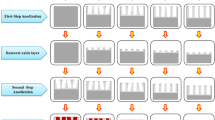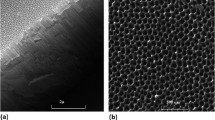Abstract
Understanding and controlling the magnetic behavior of nanowire (NW) arrays is a fundamental step for develo** novel future-generation devices. The current research investigated the role of copper pre-plating thickness on the structural and magnetic interactions of cobalt NW arrays. The NWs were grown in the anodic aluminum oxide (AAO) templates with a nanopore diameter of 30 nm by using a pulse electrodeposition (PED). The thickness of Cu pre-plating varied by adjusting the amount of electrodeposition (ED) Coulomb charge to about 0.03–0.7 C. The intensity of the Co-hcp peaks in the X-ray diffraction (XRD) pattern changes with the increase of Cu pre-plating, which can be related to ion mobility and growth kinetics during the ED process. The hysteresis curves indicate that effective magnetic anisotropy fields (\({\text{H}}_{\text{A}}^{\text{eff}})\) increase from 7200 to 11,000 Oe with increasing Cu thickness. The coercivity of Co nanowire arrays without Cu pre-plating was 1170 Oe and rose to 1870 Oe for optimum Cu thickness with 0.3 C pre-plating. The switching field distribution (SFD) extracted from hysteresis curves agrees well with the squareness ratio. Also, the SFD indicates an exchange coupling between the interfaces of the magnetic phases in the optimum sample. The regions formed in the first-order reversal curve (FORC) diagram showed crystalline features and magnetic phase interactions between the intra and inter-wire. Further, the FORC analysis showed the same crystalline features as those obtained from the XRD structural analysis.





Similar content being viewed by others
Data Availability
Data are contained within the article that origin data are available upon request from the corresponding author.
References
Zamani Kouhpanji, M.R., et al.: Selective detection of cancer cells using magnetic nanowires. ACS Appl. Mater. Interfaces 13(18), 21060–21066 (2021)
Andrade, V.M., et al.: Bilayered soft/hard magnetic nanowires as in-line writing heads. Mater. Des. 222, 111024 (2022)
Bran, C., et al.: Magnetization ratchet in cylindrical nanowires. ACS Nano 12(6), 5932–5939 (2018)
Mendes, R., Santos, J., Barreto, F.S.: Magnetic properties of a hexagonal nanowire system with mixed spin: application of the stochastic Glauber dynamics with mean-field approximation. J. Phys. Chem. Solids 170, 110896 (2022)
Chan, T.-C., et al.: Growth of large-scale nanotwinned Cu nanowire arrays from anodic aluminum oxide membrane by electrochemical deposition process: controllable nanotwin density and growth orientation with enhanced electrical endurance performance. Nanoscale 6(13), 7332–7338 (2014)
Huang, C., et al.: Improved microstructure and magnetic properties of iron–cobalt nanowire via an ac electrodeposition with a multistep voltage. Mater. Lett. 64(22), 2465–2467 (2010)
Nielsch, K., et al.: Self-ordering regimes of porous alumina: the 10 porosity rule. Nano Lett. 2(7), 677–680 (2002)
Wang, Z., Brust, M.: Fabrication of nanostructure via self-assembly of nanowires within the AAO template. Nanoscale Res. Lett. 2, 34–39 (2007)
Ghaffari, M., Ramazani, A., Kashi, M.A.: Improvement in the microstructure and magnetic properties in arrays of dc pulse electrodeposited Co nanowires induced by Cu pre-plating. J. Phys. D Appl. Phys. 46(29), 295002 (2013)
Arefpour, M., et al.: Electrochemical pore filling strategy for controlled growth of magnetic and metallic nanowire arrays with large area uniformity. Nanotechnology 27(27), 275605 (2016)
Akhtarianfar, S., et al.: The effect of barrier layer conditions on the electrodeposition efficiency and magnetic properties of Fe nanowire arrays. Appl. Phys. A 124, 1–10 (2018)
Ahmadzadeh, M., et al.: Electrodeposition efficiency of Ni in the fabrication of highly ordered nanowire arrays: the roles of Cu pre-plating and barrier layer temperature. Appl. Surf. Sci. 356, 687–694 (2015)
Yong, R., et al.: The effect of substrate on magnetic properties of Co/Cu multilayer nanowire arrays. Chin. Phys. B 18(8), 3573 (2009)
Huang, X., et al.: Initial growth of single-crystalline nanowires: from 3D nucleation to 2D growth. Nanoscale Res. Lett. 5, 1057–1062 (2010)
Huang, X., et al.: Orientation-controlled synthesis and ferromagnetism of single crystalline Co nanowire arrays. J. Phys. Chem. C 112(5), 1468–1472 (2008)
Alirezaei, B., et al.: Magnetic properties and reversal modes of electrodeposited CoCr nanowire arrays with different diameters. J. Supercond. Novel Magn. 34(12), 3199–3208 (2021)
Esfahani, M.N., et al.: Fabrication and magnetic characteristics of electrodeposited FeCr nanowire arrays. J. Magn. Magn. Mater. 537, 168218 (2021)
Sousa, C., et al.: Precise control of the filling stages in branched nanopores. J. Mater. Chem. 22(7), 3110–3116 (2012)
Sousa, C.T., et al.: A versatile synthesis method of dendrites-free segmented nanowires with a precise size control. Nanoscale Res. Lett. 7(1), 1–7 (2012)
Schloerb, H., et al.: Magnetic nanowires by electrodeposition within templates. Phys. Status Solidi B 247(10), 2364–2379 (2010)
Wang, M., et al.: Growth orientation control of Co nanowires fabricated by electrochemical deposition using porous alumina templates. Cryst. Growth Des. 18(1), 479–487 (2018)
Sharma, G., Pishko, M.V., Grimes, C.A.: Fabrication of metallic nanowire arrays by electrodeposition into nanoporous alumina membranes: effect of barrier layer. J. Mater. Sci. 42, 4738–4744 (2007)
Jafari-Khamse, E., Kashi, M.A., Ramazani, A.: Angular dependence of interactions in polycrystalline Co nanowire arrays. Mater. Chem. Phys. 159, 128–138 (2015)
Bottoni, G., Candolfo, D., Cecchetti, A.: Distribution of anisotropy field in recording media deduced from the hysteresis curve. J. Appl. Phys. 81(8), 3794–3796 (1997)
Salem, M.S., et al.: Magnetic characterization of nickel-rich NiFe nanowires grown by pulsed electrodeposition. J. Mater. Chem. 22(17), 8549–8557 (2012)
Vivas, L., et al.: Magnetic anisotropy in CoNi nanowire arrays: analytical calculations and experiments. Phys. Rev. B 85(3), 035439 (2012)
García, J., et al.: Magnetization reversal dependence on effective magnetic anisotropy in electroplated Co–Cu nanowire arrays. J. Mater. Chem. C 3(18), 4688–4697 (2015)
Hauet, T., et al.: Reversal mechanism, switching field distribution, and dipolar frustrations in Co/Pt bit pattern media based on auto-assembled anodic alumina hexagonal nanobump arrays. Phys. Rev. B 89(17), 174421 (2014)
Lobo Guerrero, A., et al.: Crystalline texture of cobalt nanowire arrays probed by the switching field distribution and FORC diagrams. J. Phys. D Appl. Phys. 56(6), 065003 (2023)
Kashi, M.A., Ghaffari, M., Torshizi, F.: Structural and magnetic tunability of Co/Cu multilayer nanowires induced by electrolyte acidity and spacer layer thickness. J. Alloy. Compd. 820, 153087 (2020)
Panagiotopoulos, I.: A simple approach to the First Order Reversal Curves (FORC) of two-phase magnetic systems. J. Magn. Magn. Mater. 323(16), 2148–2153 (2011)
Gilbert, D.A., et al.: Quantitative decoding of interactions in tunable nanomagnet arrays using first order reversal curves. Sci. Rep. 4(1), 4204 (2014)
Funding
Iran National Science Foundation, 95841951.
Author information
Authors and Affiliations
Corresponding author
Ethics declarations
Conflict of Interest
The authors declare that they have no known competing financial interests or personal relationships that could have appeared to influence the work reported in this paper.
Additional information
Publisher's Note
Springer Nature remains neutral with regard to jurisdictional claims in published maps and institutional affiliations.
Rights and permissions
Springer Nature or its licensor (e.g. a society or other partner) holds exclusive rights to this article under a publishing agreement with the author(s) or other rightsholder(s); author self-archiving of the accepted manuscript version of this article is solely governed by the terms of such publishing agreement and applicable law.
About this article
Cite this article
Alicheraghi, L., Ghasemi, A., Paimozd, E. et al. Insight into the Intra and Inter-wire Magnetic Interactions of Co Nanowire Arrays by FORC Diagrams. J Supercond Nov Magn (2024). https://doi.org/10.1007/s10948-024-06736-3
Received:
Accepted:
Published:
DOI: https://doi.org/10.1007/s10948-024-06736-3




